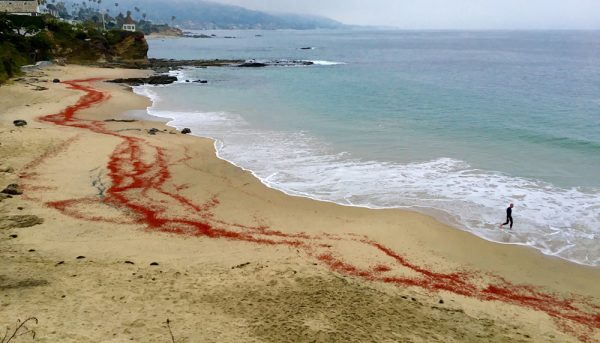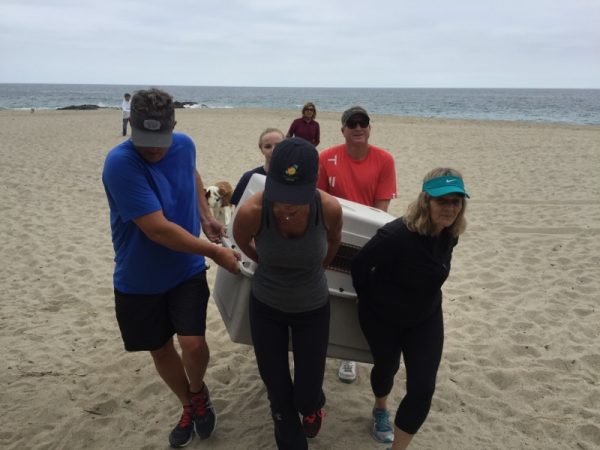The impact of El Nino ocean currents was evident on local beaches in the last week, where beachgoers encountered unusually underweight baby elephant seals and a stranded army of tiny lobster-like red crabs.

Photo by Lori Zappas.
Passersby at West Street Beach spotted a young male elephant seal Saturday. Five beachgoers helped Pacific Marine Mammal Center animal rescue coordinator Malena Berndt carry the malnourished 82-pound pinniped in a kennel up 189 steps to Coast Highway, according to south Laguna resident Lori Zappas, one of several people who called PMMC for the rescue.
“It really wasn’t that much of an effort to get him up the steps,” said Zappas.
The animal was 100 pounds underweight. Berndt transported the sickly seal to the marine mammal rehabilitation center in Laguna Canyon, the only designated sea mammal rescue center along the entire Orange County coastline. The center has been at capacity for sick sea lions since 2013.
Berndt followed the same drill last Friday when she rescued another young male elephant seal at Aliso Beach, also in South Laguna, said Wendy Leeds, another PMMC animal rescue coordinator. This one was 92 pounds. Both pups are still in critical condition, said Leeds, and slowly being tube-fed.
At three to four months old, the pups are still at birth weight, said Leeds. “They should be well over 200 pounds by now,” she said. “The pups should be nice, huge and fat.”
The West Street rescue was named Akela and the Aliso Beach pup Baloo from the movie “The Jungle Book.” On Monday, both were still listless but mending, said Leeds, who expects them to take two weeks to recover.
The pups are malnourished due to either an inadequate milk supply from a malnourished mother or leaving the rookery too soon to forage for food on their own, Leeds said.

Sea lion mothers experience difficulty finding enough food because of warm-water El Nino conditions. The warm ocean currents prevent upwelling of colder, deeper water, which normally brings fish that sea lions eat to the surface, according to reports from the National Oceanic and Atmospheric Administration.
In January and February, strandings of sea lion pups exceeded that of 2014 and 2013 when NOAA first declared an “unusual mortality event.” Most of the strandings have occurred in the first four months of the year, much earlier and at much higher levels than the historic averages, said Jim Milbury, a NOAA spokesman in Long Beach.
El Nino currents from Baja California also sweep in other warm-water species unusual to colder Pacific Ocean waters. These include the thousands of red pelagic or tuna crabs strewn dead and alive along local shores over the past two years, said Jeremy Frimond, Laguna Beach’s marine protection officer.
This time around, the crabs were dropped at tidelines along only south-facing beaches from central to north Laguna, he said, with the surf washing most of them back into the sea.
“I am sure the gulls in the region have been sustaining themselves off these crustaceans for the past several years,” said Frimond. But gulls aren’t feasting as voraciously this time, probably due to springtime breeding and nesting, he said.
Both the recently rescued elephant seal pups, which will eventually develop the large male proboscis, should still be romping on their rookeries, either at Ano Nuevo in northern California or San Simeon on the central California coast, Leeds said. Elephant seal mothers stay with their young only one month, leaving them to play, swim and learn how to hunt on their birth-home shores.
With 12 injured elephant seals, PMMC is pushing capacity for sick and injured pinnipeds, including 103 sea lions, which have been treated at the center in record-breaking numbers since 2013, she said. Many of the sea lions are coming in with adult shark bites, said Leeds, who rescued an adult female off the Dana Point Harbor jetty struggling due to a shark bite from her nose to her front flipper. “Yeah, a big bite radius,” she commented.
Akela was also wounded, she said, with a cut across her throat. The puncture could be from attempting to eat a rat fish or stingray, both of which strike with sharp barbs, according to a PMMC report.
Bigger sharks, said Leeds, are coming closer to shore this year due to the warmer waters bringing fish the sharks feed on closer to shore. “It’s like a smorgasbord out there,” she said.




